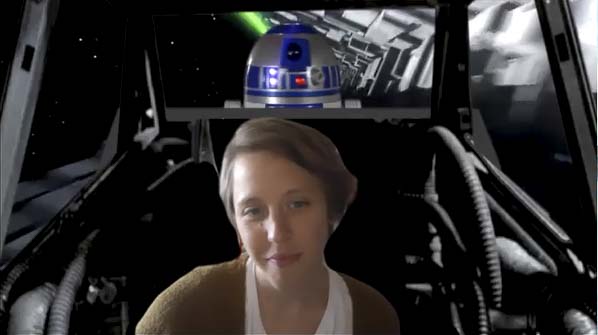SLPs help address many communication skills including auditory processing disorder, language disorders, social communication disorder, and reading disabilities
BATTLE GROUND — Hillary Betzen sits in the cockpit of her X-wing, as her faithful droid companion, R2-D2, is positioned behind her serving as navigator on yet another critical mission. This image may be borrowed from the famous Star Wars scene in which Luke Skywalker saves the day, but in real life, Betzen and R2 are heroes of education, helping Battle Ground Public Schools students overcome a wide range of speech, communication and reading issues.

Betzen, who works at River HomeLink, is one of the district’s Speech Language pathologists, or SLPs. She uses images from Star Wars and other popular movies and video games as her Zoom video conference background to help engage with students who are learning from home.
“We’re used to employing a wide range of methods to connect with students,” Betzen said. “Taking advantage of Zoom’s custom backgrounds is a way to get kids excited about working with me from home.”
SLPs are part of the district’s special education team. They help address many communication skills including auditory processing disorder, language disorders, social communication disorder, and reading disabilities. They also work with kids who have nonverbal learning disabilities and require devices to communicate. They might help a child improve their conversation skills, or help struggling readers learn phonological awareness and gain comprehension.
No matter what skills they may be addressing, the goal is always to help improve how well a child is learning and performing in the classroom. SLPs work with kids both one-on-one and in small groups, and they often coordinate with general and special education teachers to support an individual child.
“Speech therapy is only one part of what speech language pathologists do,” said AnnMarie McLarrin, SLP at Captain Strong Primary School. “We’re here to help support anything and everything that helps improve students’ ability to communicate effectively and to learn.”
Like all school employees, SLPs have had to adapt their lesson plans to the current remote learning environment. Speech therapy, occupational therapy, and mental health teletherapy services have existed in the private sector for the last 10-plus years, so school-based SLPs have been able to take advantage of existing online resources. One example is Boom Learning, which has hundreds of visual and interactive language and communication activities that are easy to use and designed to be fun for young learners.
“It’s been really wonderful to engage with students and see their little faces light up,” McLarrin said. “The learning and connection is still there, even if it’s delivered through a computer screen.”
Even when SLPs are able to meet with students face-to-face in a normal learning environment, the nature of their work requires them to individualize treatment to meet the unique needs of each student.
“Treatment looks different depending on the student we’re working with, and it’s about adapting to families’ needs as well as the students’,” said April Amonson, SLP at Tukes Valley Middle School. “Even with remote learning, we are still creating plans for each individual student, but we are now extra focused on taking family situations into account. Some families have access to the internet and enough devices at home to work one-on-one via teletherapy, while others need paper packets and can check in occasionally online.”
Amonson uses Google Classroom, which the district uses as its online learning platform and her middle school students already have familiarity with. She can post and assign online activities that students can complete individually. Students with articulation issues or speech errors create audio recordings that can easily be uploaded to Google Drive, where Amonson can review and provide feedback.
For Amonson’s students who need help socializing, group Zoom meetings offer the chance for several students to meet simultaneously to practice social activities. For one recent activity, Amonson met with a small group of her students via Zoom to do some light yoga, where each student chose a pose and instructed the rest of the group on how to do it properly.
Despite the challenges, the district’s SLPs say there are some benefits to learning remotely.
“The school-to-home connection right now is phenomenal,” Betzen said. “Before, I’d be working with kids at school and sending them home with work, but the current learning environment is allowing for more direct connection and collaboration with parents, who play a huge role in the success and progress of students. I’ve seen some amazing progress happen.”
AnnMarie McLarrin echoed that sentiment. “I love the idea that parents are right there beside their kids and seeing what we’re working on. They’re seeing how—through creativity and imagination—students are learning to verbalize, participate in conversation, and follow directions.”
“Remote learning is helping us look at kids more holistically,” Amonson said. “Now that students are at home with their families, we are better able to get a complete picture of how to best help students. We can see what is impacting them in their daily lives, and learning how we can better help them communicate based on their individual needs.”
Information provided by Battle Ground Public Schools.




